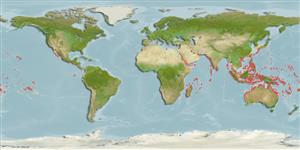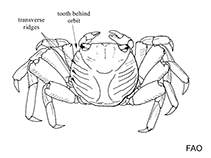Grapsus tenuicrustatus (Herbst, 1783)
Natal lightfoot crab| Native range | All suitable habitat | Point map | Year 2050 |

|
| This map was computer-generated and has not yet been reviewed. |
| Grapsus tenuicrustatus AquaMaps Data sources: GBIF OBIS |
Upload your photos
Google image | No image available for this species;
drawing shows typical species in Grapsidae.
Google image | No image available for this species;
drawing shows typical species in Grapsidae.
Classification / Names Common names | Synonyms | CoL | ITIS | WoRMS
Malacostraca | Decapoda | Grapsidae
Environment: milieu / climate zone / depth range / distribution range Ecology
Benthic; depth range 0 - 6 m (Ref. 96667). Tropical
Distribution Countries | FAO areas | Ecosystems | Occurrences | Introductions
Indo-Pacific: Red Sea to French Polynesia and Hawaii.
Length at first maturity / Size / Weight / Age
Maturity: Lm ? range ? - ? cm Max length : 8.0 cm CW male/unsexed; (Ref. 343)
Short description Morphology
Carapace rounded; front straight, finely serrated; anterolateral margins rounded, each with 1 tooth; lateral regions with numerous oblique striae. Fingertips slightly spooned. Color: carapace with green and white transverse markings.
Also caught by special nets. Found out of the water, on rocks in the splash zone (Ref. 343). Intertidal (Ref. 106854).
Life cycle and mating behavior Maturity | Reproduction | Spawning | Eggs | Fecundity | Larvae
Members of the order Decapoda are mostly gonochoric. Mating behavior: Precopulatory courtship ritual is common (through olfactory and tactile cues); usually indirect sperm transfer.
Main reference
References | Coordinator | Collaborators
Ng, P.K.L. 1998. (Ref. 343)
IUCN Red List Status (Ref. 130435)
CITES status (Ref. 108899)
Not Evaluated
CMS (Ref. 116361)
Not Evaluated
Threat to humans
Human uses
Fisheries: subsistence fisheries
| FishSource |
Tools
More information
Internet sources
BHL | BOLD Systems | CISTI | DiscoverLife | FAO(Publication : search) | Fishipedia | GenBank (genome, nucleotide) | GloBI | Gomexsi | Google Books | Google Scholar | Google | PubMed | Tree of Life | Wikipedia (Go, Search) | Zoological Record
Estimates based on models
Preferred temperature
(Ref. 115969): 24.6 - 29.3, mean 28.3 (based on 3483 cells).
Price category
(Ref. 80766):
Unknown.



